How to Grow, Harvest, and Preserve Bee Balm (Monarda)
This post may contain affiliate links, which means that I may receive a commission if you make a purchase using these links. As an Amazon Associate I earn from qualifying purchases.
In our attempts to save the bees, many of us are adding more flowering plants to our gardens.
Monarda is a popular perennial plant used in bee and butterfly gardens. It is commonly known as Bee Balm and its fragrant blossoms attract bees, hummingbirds, butterflies, and other pollinating insects. Monarda also has a long history of medicinal uses by Native American tribes, American Eclectic physicians, the Shakers, and herbalist.
Bee balm is a member of the mint family (Lamiaceae). There are over 15 species and over 50 different cultivars of bee balm that grow both wild and in gardens. Colors range from bright red to lilac to shades of pink and white.
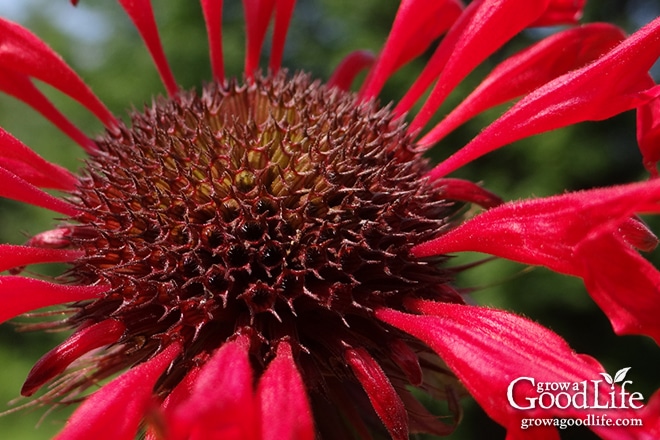
Monarda didyma is the variety I grow in my perennial garden bed. It is also known as Scarlet Bee Balm, Oswego Tea, and Crimson Bee Balm. The plant grows in dense clusters with striking red flowers that bloom on 3-foot high stems in mid to late summer.
Monarda didyma is a perennial native to Eastern North America and Canada and grows naturally from Quebec to Georgia and west from Ontario to Minnesota and down to Missouri. It is also native to Washington and Oregon in the west. (Source: USDA)
History of Bee Balm
The genus Monarda was named for Spanish physician and botanist Nocholas Monardes, who published some of the first European books on American native plants in the late 1500s. However, the Native American tribes of Eastern North America and Canada used Monarda didyma medicinally for centuries before Nocholas Monardes studied the plant. (Source: Foster)
Monarda didyma common name of “bee balm” is attributed to the use of the herb for soothing bee stings. North American tribes in the eastern United States used the herb to ease the pain of mild abrasions and bee stings by crushing the leaves of the plant and rubbing them on the skin. The name, “Oswego tea,” is originated from the Native Americans living near the present-day city of Oswego in upstate New York who showed early settlers how to make an herbal tea from the leaves of the plant. Monarda didyma was used as a black tea replacement after the Boston Tea Party. (Source: USDA)
Culinary and Medicinal Uses of Bee Balm
Monarda has a long history of medicinal uses by Native American tribes, American Eclectic physicians, and the Shakers. As a tea, it was used to soothe cold symptoms, including congestion, headache, and sore throats. Inhaling the fumes of steamed leaves was credited to help clear sinuses. Monarda has also been used for stomach issues such as gas, nausea, and vomiting, to reduce muscle spasms, and as a diuretic. (Source: Heatherly)
Monarda contains high concentrations of thymol, which is a strong antiseptic that is common in mouthwashes. The Native Americans used poultices made from the leaves of the plant for skin infections and minor wounds, and as a tea for mouth and throat infections caused by dental issues and gingivitis. (Source: Foster)
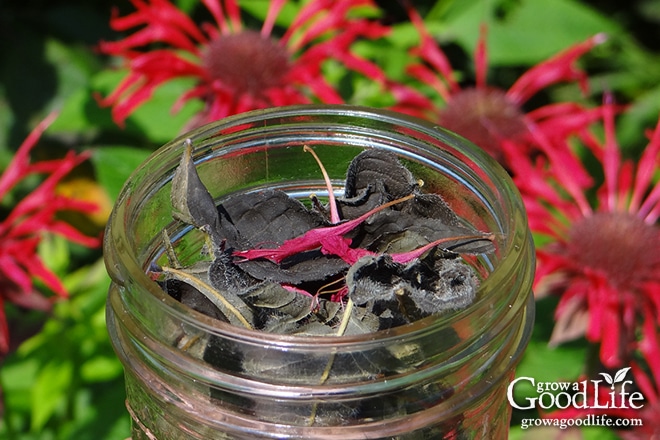
Each variety of bee balm has a slightly different flavor. The foliage of Monarda didyma has a minty sage and oregano blended flavor. Not sweet mint like peppermint, but more pungent making it a nice compliment to roasted meats and wild game. The petals are milder in flavor and can be tossed into both leafy and fruit salads to add a bit of spice and a burst of color.
How to Grow Bee Balm
Bee balm grows in a clump with 3-foot tall stalks. Most bee balm varieties are perennials and will grow in average to well-drained soil in full sun. You can grow bee balm from seed, but it establishes quicker when planted from divisions from a friend’s garden or purchased plants from your local garden center.
Like other herbs in the mint family, bee balm is considered to be a bit invasive. It will easily self-sow and also spreads by underground rhizomes. If you give it plenty of room in your garden, you will be rewarded with a beautiful display of bright blooms each year.
Select an area towards the back of your garden so it will not shade other plants. Plant bee balm in groups of five or more for a mass of color. The native types of Bee Balm are vulnerable to powdery mildew. Plant in full sun and provide plenty of air circulation or seek out varieties that are more tolerant to powdery mildew.
Bee Balms prefer moist soil that is rich in organic matter. Prepare your garden bed by removing all the weeds and amending with some compost and fertilizer. If the weather has been dry, prepare the bed the day before you plant and water the bed very well. Space plants 18 to 24 inches apart and water in very well. Mulch to conserve moisture.
If you are growing bee balm from seed, start seeds indoors under lights 8-10 weeks before your average last frost date. Harden off your seedlings and transplant to your garden after all danger of frost is past. Perennial plants started from seeds will bloom the second year. Try to avoid harvesting foliage for the first year so the plant can use all its energy to become well established. For more information on growing from seed, please see: 10 Steps for Starting Seeds Indoors and How to Harden Off Seedlings.
Once established, bee balm is very trouble free and requires very little maintenance. Blooms begin in July and continue until late summer. Deadheading spent blooms will prevent seeds from self-sowing and encourage the plants to continue to flower longer. Divide the plants every 2 to 3 years if the center dies out or if the plants spread further than you want. Dig up plants in spring when growth first emerges, divide, and replant in another location or share divisions with your friends and neighbors.
How to Harvest and Preserve Bee Balm
Harvest mid-morning after the dew has evaporated for the greatest flavor. Harvest by clipping the base of the stalk. Gather the stalks by their stems, tie the ends, and hang to dry. Or you can pluck the leaves and petals from the stalks, spread them out on a screen and allow them to dry naturally away from dust and sunlight. Depending on the humidity level, drying can take 1-2 weeks.
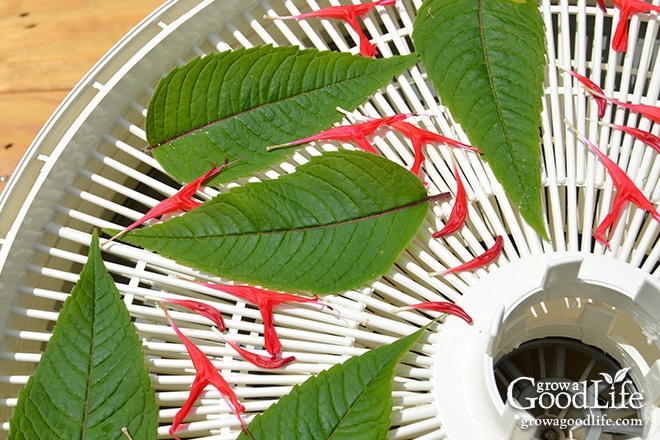
The quickest way to dry bee balm is by using a dehydrator. Spread the leaves out on the screens and dry at a low temperature. Check every 30-minutes until completely dry. You can tell when the leaves are dry, by crushing a leaf or two. It should crumble easily. Once dry, store leaves lightly packed in a glass jar away from direct sunlight. Try not to crush them to preserve the flavor until you are ready to use.
How to Use Bee Balm
Bee balm tea can be made from both fresh and dried leaves. I find the flavor of tea made from Monarda didyma to be rather strong. To make tea, start with about 1-teaspoon of crushed, dried bee balm leaves per 8-ounce cup of boiling water. Steep for at least 5 minutes and drink like regular tea. If you like the bold flavor of Earl Grey tea, you will find the flavor quite similar. Use fewer leaves for a lighter flavored tea.
Visit the links below for more ways to use bee balm:
- 5 Ways to Use Bee Balm by Homespun Seasonal Living
- 12 Ways to Use Bee Balm by Practical Self Reliance
- Benefits of Bee Balm: Monarda Fistulosa and M. Didyma by The Herbal Academy
- How and Why to Make a Bee Balm Oxymel by Homespun Seasonal Living
Do you want to learn more about how to use herbs as medicine?
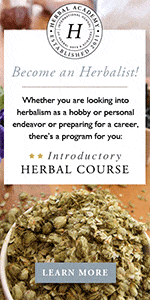 Herbal Academy Online Courses: No matter where you are in your herbal studies, the Herbal Academy has a training program for you!
Herbal Academy Online Courses: No matter where you are in your herbal studies, the Herbal Academy has a training program for you!
- The Introductory Herbal Course is a good place to start if you are new to herbal medicine.
- The Intermediate Herbal Course begins with an introductory unit as a review, and then quickly advances into more complex topics.
- The Entrepreneur Herbal Course is geared towards herbalists who have already studied at the beginner and intermediate levels, who want to make and sell their own herbal products.
- The Advanced Herbal Course is an in-depth program geared towards students interested in becoming clinical herbalists.
Resources and Further Reading:
Foster, Steven, and Rebecca L. Johnson. Desk Reference to Nature’s Medicine. Washington, D.C.: National Geographic, 2008. 34-35. Print.
Heatherley, Ana Nez. Healing Plants: A Medicinal Guide to Native North American Plants and Herbs. New York, NY: Lyons & Burford, 1998. 22. Print.
Lester, Randall K. and John Vandevender. Plant Guide for scarlet beebalm (Monarda didyma). Alderson, WV: USDA Natural Resources Conservation Service, 2015. Web. Feb. 07. 2016.
“Plant of the Week.” Scarlet Beebalm. USDA. Web. Feb. 07. 2016.
I am not a doctor, and the statements on this website have not been evaluated by the FDA. It is recommended that you consult your medical care provider or herbalist prior taking or relying upon any herbal product.
Good planning is key to a successful vegetable garden
Whether you are new to growing your own food or have been growing a vegetable garden for years, you will benefit from some planning each year. You will find everything you need to organize and plan your vegetable garden in my PDF eBook, Grow a Good Life Guide to Planning Your Vegetable Garden.
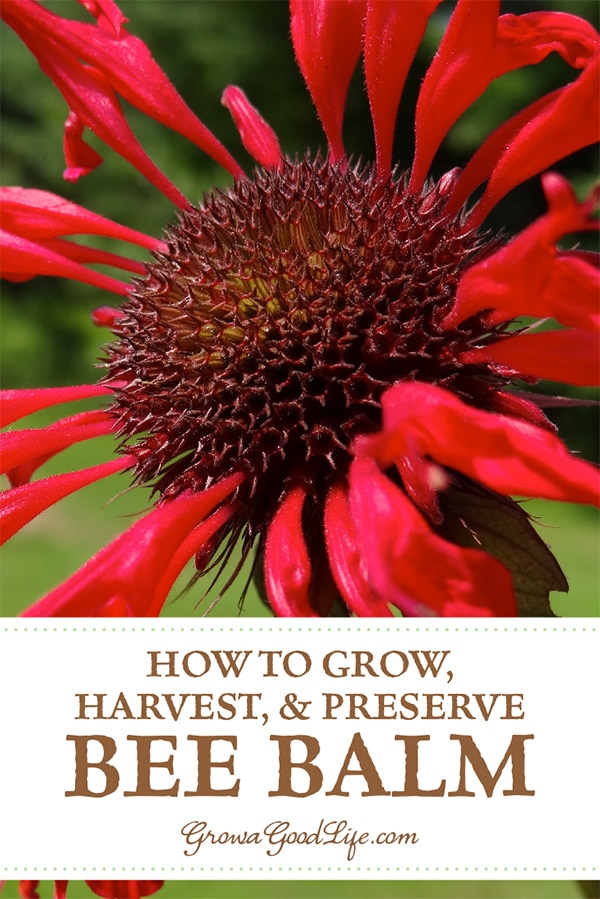


Last season some of my bee balm got powdery mildew and it died off. Now some of its come back and looks pretty healthy. Is this bee balm that’s come back safe to harvest?
Alicia, Yes, as long as the leaves are healthy, you can harvest the foliage. Powdery mildew is pretty common for bee balm, but the plant itself is quite resilient.
Thank you for such a thorough post. A lot of my bee balm has powdery mildew on its leaves. Is it safe to use?
Susan, No, I wouldn’t use sick or diseased leaves.
Can you harvest the seeds from the plant in the fall and plant them?
Terri, Yes, you can harvest and sow the seeds.
I’m new to this plant. Just bought some today and will take your suggestions. Thank you for sharing. I do buy bergamot tea. So happy that I can brew my own. Bless you
Are all bee balm/bergamont varieties usable?
I have white wild bergamont here in Missouri.
But I also have some domestic magenta pink bee balm.
Louise, Yes, the majority of bee balm species can be eaten. Some taste better than others.
I took the time to read a little of your blog this morning.
Just needed to thank you as you have inspired me.
Newer to gardening. Have learned it’s definitely a wonderful
journey…not a destination.
Donna, Thank you so much for your comment and kind words. It is indeed a journey and not a race to get there all at once. Begin small and experiment with growing different things every year.
My grandmother used to make Bee balm tea very often no matter what season it was.The best memories of my childhood were with this tea in the cold winter nights. Now, my kids don’t like the taste of the tea when I make it for them.
Add honey & cinnamon for enhanced flavor and added medicinal benefits:)